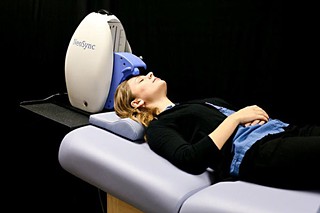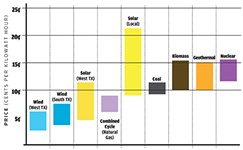The Egg & I
How an experimental treatment for major depression introduced me to the medical magnet and the return of 'energetic' medicine
By Greg Harman, Fri., Aug. 23, 2013
(Page 3 of 3)
Science or Fiction?
When my own health deteriorated in 2012 and electroshock was urged, I made up my mind to first try TMS. The trouble was the cost. My insurance provider, Aetna, refused to cover the treatment, calling it "experimental and investigational." The price of $500 per session I was quoted (multiply that by an estimated 30 sessions, as is typically recommended) had me swooning, even as the woman on the other end of the line said cheerfully, "We do offer financing."
I began to scour medical trials online for TMS-related studies. That's where I discovered NeoSync's "egg," and what may become the latest magnet-based depression therapy to enter the mental-health market. All told, the magnetic devices manufactured by groups like NeoSync, Neuronetics, and Brainsway represent a growing movement away from purely biochemical treatment options, and the rise of "energetic" medicine, a growing acknowledgment of fundamental principles informing many traditional healing systems, though packaged and sold in decidedly science-fiction skins.
First to the market, the NeuroStar TMS device releases 3,000 pulses of electromagnetic energy per treatment session that generate an extremely weak electric current about an inch inside the left side of the frontal portion of the brain – the dorsolateral prefrontal cortex. Those currents have been shown to increase blood flow, elevate metabolic processes, including the production of glucose, and re-engage neurons. And TMS's promise appears to be growing as methods of delivery are tweaked.
A 2012 study led by Dr. Linda Carpenter, chief of the Mood Disorders Program and the Neuromodulation Clinic at Butler Hospital, surveyed 307 clients of 42 clinical TMS therapy sites and reported an overall positive response rate of 58% among those who had been unable to benefit from previous anti-depressant treatment; 37% achieved full remission. In a follow-up study presented at the annual meeting of the American Psychiatric Association in San Francisco earlier this year, Carpenter reported that 68% of 257 patients observed 12 months after treatment with 4-6 weeks of daily TMS and continued anti-depressant treatment showed "significant improvement," and 45% were in full remission.
Marilyn Vaché at the Austin TMS Clinic for Depression said her results have been even better. "At least 65 percent have had that significant improvement. That means if they started out with severe they went down to mild. If they started out with moderate to mild they went down to remission. Fifty-one percent were in the remission category," Vaché said.
Konyecsni, who only started offering TMS at his psychiatric practice about a year ago, said all eight of his adult patients have achieved remission.
Signs of Trial
Martha Rhodes first received TMS treatment in 2010. Like me, the former NYC ad exec had suffered for decades, done poorly on a range of pharmaceuticals, and shied away from ECT. She was desperate for something outside psychiatry's traditional toolbox when her sister faxed her a full-page ad from Connecticut Magazine trumpeting the "newest technology to treat depression without discomfort or drugs."
For Rhodes, TMS took three weeks to start pulling her out of her death-wish depression, and that followed a dangerous mood dip in week two. "Your brain is being reconnoitered," the author of 3,000 Pulses: Surviving Depression with TMS and 3,000 Pulses Later: A Memoir of Surviving Depression Without Medication told me. "You could experience happiness, then sadness, then happiness again. It takes, I'm going to say, a good 20 visits."
In my dim room, I drifted through multiple levels of awareness as the egg did its thing in the fourth week of the trial. Out of the darkness and the day's troubled thoughts I felt a moth fluttering against my right ear and cheek. Would I break protocol if I swiped after it? Opened my eyes? I mentally tracked the fluttering for what felt like minutes. Velvet wings brushed against the invisible hairs above the earlobe, almost imperceptible insect steps moved along the ear's ridge before the fluttering sensation resumed again. It dawned on me that the likelihood a moth was haunting the research hospital testing room was probably low.
Were these nerves activating? I watched again and observed a slender pain move through the inside of my cheek. Felt another energetic tentacle spread behind my eye. If the electrical stimuli around my head and face suggested I was not getting the placebo treatment, a coexistent surge of sadness – brought on by my inability to get insurance due to my mental-health history – also meant that even a cutting-edge depression-buster wasn't an automatic happy pill.
In those first weeks, I'd gone through days of high agitation, suffered a multiday migraine, and started having trouble sleeping – all things the attending doctor warned I could experience. But I'd also discovered newfound physical energy and a noticeably sharpened mental acuity that allowed me to steam through book after book on psychology, psychiatry, electromagnetism, religion, and shamanism. "The stuff is happening," I wrote at the time. "I'm sure it's the device."
Mesmer Rising
I have questions about the trial, but regrettably, NeoSync chose not to participate in this story. The Office of the Attorney General of Texas, meanwhile, supported arguments made by UT Southwestern to keep secret specifics of the study I requested under the state's open-records law.
Researchers had been examining transcranial magnetic stimulation, or TMS, for its ability to aid in the treatment of Parkinson's, tinnitus, schizophrenia, and the recovery from stroke symptoms for years. When I dug into the literature, I found that magnetic fields are foundational to both the geophysical and the biological. Life evolved in Earth's reliable field of 8 pulses per second and everything from antibiotic treatment, cellular healing, and mental regeneration have all been shown to be influenced by them. Electromagnetic fluctuations from our star have been shown to have real impacts on our health. Validating theories of that 18th century healer and proponent of "animal magnetism" Franz Mesmer, researchers have been able to link sunspot activity disrupting our natural geomagnetic field with increased rates of psychotic behavior and institutionalization.
Michael Persinger, a researcher at the Consciousness Research Lab at Laurentian University, even found a correlation between 37 years of haunting reports and recorded geomagnetic activity. He published his findings in Neuroscience Letters in 1998, as detailed in Mary Roach's book Spook: Science Tackles the Afterlife, and went on to demonstrate that drops in melatonin levels brought on by exposure to high electromagnetic frequencies can inspire encounters with "synthetic ghosts" in a laboratory setting.
Small Steps Forward
My energetic rush, a generative vitality I hadn't felt in many years, continued for about two months post-treatment. In my first two weeks back in San Antonio, I set up a home office, fixed a collapsed wall shelf and assembled a floor shelf for my daughter's room, got caught up on all my bills, patched my windshield and changed my oil, dragged two old bathtubs around the backyard for a lettuce patch and a pond, did my laundry, got my hair cut, swept and mopped the house twice. The list goes on. I was functioning on a level vastly higher than I had been before treatment – still without drugs.
I came out in far better shape than I went in. But there has been a retrenchment of late, a slow return of brooding and ambivalence. "The whole concept of TMS is still theoretical. However, data would clearly suggest that the technology works," said John Carnuccio, CEO of NeoSync. "Duration is an uncertain, an unknown."
Rhodes suffered a relapse, but pulled out with 10 TMS treatments and now receives TMS twice a month for maintenance, she said. She's not an anomaly. "Based on my experience, there's probably a third of people who will relapse and need additional treatments," Vaché told me. "If we catch them early, we can sometimes get them back with three to 15 treatments." Given that depression tends to be a "lifelong" condition, Carnuccio said he hopes his company's device will be one people will be able to check out from their doctor's offices for self-administered daily home treatments. "It's a pretty simple device," he said. "It can be done in most hands, but not everyone's hands. But that's our objective."
In an interesting twist, "lots" of trial participants developed the need for traditional therapy during the NeoSync trial in Dallas, many for the first time. "Because they have all these new emotions bubbling up," the doctor with curls told me, waggling her fingers in the air. "Drugs and this [gesturing to the egg] can't do everything."
From the couch, I pine for the coming health care reforms of the Affordable Care Act that will force the insurance companies to accept people like me, people whose health and health troubles "pre-exist." While Vaché said some of her clients have been able to get their insurance providers to cover their TMS treatments, they're in the minority, and the compensation rates remain far from adequate to cover the costs of the treatments, Konyecsni added.
The egg and the growing number of devices like it do quite a lot, I've found out. If Dr. Persinger's high-frequency fields truly do create "ghosts" in the mind, the lower-frequencies provided by TMS appear equally capable of dispelling them.
At least most of the time. For a time.
Greg Harman is an independent journalist and longtime environmental reporter based in San Antonio, Texas. His environmental work can be seen at harmanonearth.com and his writings on depression are available at depression-time.com.
Got something to say on the subject? Send a letter to the editor.











